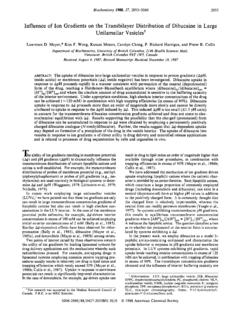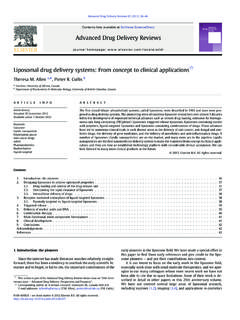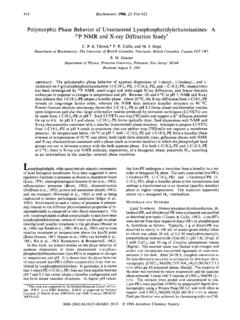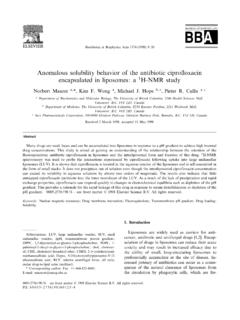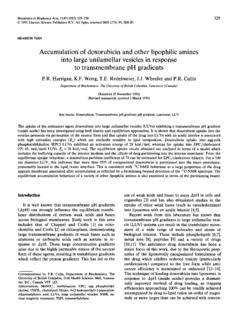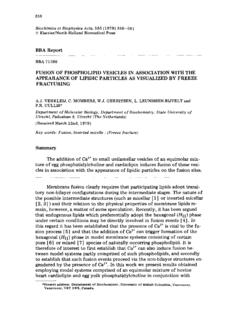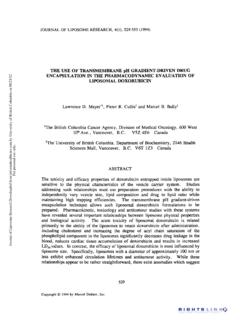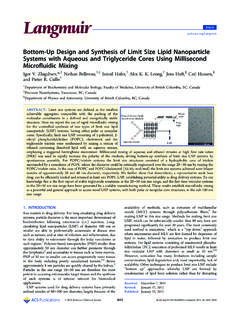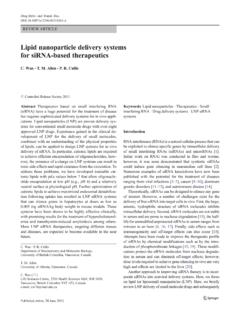Transcription of THE OP BIOLOGICAL Vol. 267, 26, 15, PP. 18759 …
1 THEJOURNAL CHEMISTRY. OP BIOLOGICAL Vol. 267, No 26, Issue of September 15, PP. 18759 - 18765 , 1992 . 0 1992 hy The American Society for Biochemistry and Molecular Biology, Inc Printed in Association of Blood Proteins with LargeUnilamellar Liposomes in Vivo RELATION TO CIRCULATION LIFETIMES*. (Received for publication, February 20, 1992 ). Arcadio ChonnS, Sean C. Semple, and PieterR. Cullis From the Department of Biochemistry, The University of British Columbia, Vancouver, British Columbia V6T 123, Canada The proteins associated with liposomes in the circu- A central problem to theuse of liposomes and othercarriers lation of mice were analyzed in order to determine for drug delivery is their rapid clearance from the circulation whether bound proteins significantly influence the fate (reviewed by Gregoriadis (1988) and Senior (1987)).
2 Although ofliposomes in vivo. Liposomes were administered the mechanisms involved in thein vivo clearance of liposomes intravenously viathe dorsal tail vein of CD1 mice and from the circulation are poorly understood, various aspects of were isolated from blood after 2 min in theabsence of liposome design are known to strongly influence liposome coagulation inhibitors using a rapid spin column pro- clearance behavior. For example, negatively charged lipo- cedure. Various negatively charged liposomes exhib- somes are cleared more rapidly than net neutral or positively iting markedly different clearance properties were charged systems (Juliano and Stamp,1975).
3 The presence of studied; notably, these included liposomes containing saturated phospholipids (Gregoriadis and Senior, 1980) or 10 mol % ganglioside G M l which has been previously equimolar amounts of cholesterol (Kirby et al., 1980; Pate1 et shown to effectively limit liposomal uptake by the fixed al., 1983; Roerdink et al., 1989) stabilize liposomes in the circulation and also reduce their uptake by the phagocytic macrophages of the reticuloendothelial system. The cells of the reticuloendothelial system. Liposomes containing protein binding ability (PB;g of protein/mol of lipid) hydrogenated plant phosphatidylinositol (Papahadjopoulos of the liposomes was quantitated and related to the and Gabizon, 1987), ganglioside G,, (Allen and Chonn, 1987.)
4 Circulation half-life ( T ~ / of ~ ) the liposomes. Liposomes Gabizon and Papahadjopoulos, 1988), or amphipathic phos- having similar membrane surface charge impartedby phatidylethanolamine derivatives of polyethylene glycols different anionic phospholipids were found to exhibit (Klibanov et al., 1990; Blume and Cevc, 1990) have been markedly different protein binding potentials. Fur- shown to exhibit extended circulation lifetimes. The basis of thermore, PB values determined from the in vivo ex- the effect of lipid composition on the clearance rate of lipo- periments werefound to be inversely related to circu- somes is not known. lation half-lives.
5 PBvalues in excess of 50 g of protein/ It is widely believed that blood proteins mediate the in- molof lipid were observed for rapidly cleared lipo- creased liposome permeability and rapid liposome uptake by somes suchas those containing cardiolipin or phospha- the reticuloendothelial system that liposomes experience in tidic acid ( T ~ <. / ~2 min). PBvalues for ganglioside Gwl- uiuo. This potential role of blood proteins in liposome clear- containing liposomes ( T ~ > / ~2 h) were significantly less ance has been studied extensively using in uitro systems ( P B <I5 g of total protein/mol of total lipid). P B values employing liposome incubations with isolated plasma or were also determined for liposomes recovered from in serum.
6 From these in uitro studies, however, there appears to vitro incubations with isolated human serum; relative be no unambiguous relation between the amount and type of P B values obtained from these in vitro experiments protein bound and liposome clearance behavior. For example, were in agreement with relative PB values measured Black and Gregoriadis (1976) reported that human a2-mac- from in vivo experiments. PB values, therefore, could roglobulin or rat al-macroglobulin was the only protein as- be a useful parameter for predicting the clearance sociated with liposomes exposed to plasma, and that this behavior of liposomes in the circulation.
7 Liposomes protein imparted a net negative liposome surface charge re- gardless of the inherentcharge of the membrane. In contrast, exhibiting increased PBvalues in vivowere shown by Juliano and Lin (1980) reported that neutral or positively immunoblot analysis to bind more immune opsonins, charged liposomes bound several plasma proteins including leading to a higher probability of phagocytic uptake. albumin, apolipoprotein Al, IgG, and a group of high molec- Finally, based on results obtained using the in vitro ular weight (>200, 000) proteins. Negatively charged lipo- system, it is suggested that the mechanism by which somes failed to bind thesehigh molecular weight components.
8 Ganglioside G Mprolongs ~ the murine circulation half- The amount of protein associated with phosphatidylserine- life of liposomes is by reducing the total amount of containing liposomes did not significantly differ from that blood protein bound to the liposomes in a relatively associated with PC:CH' multilamellar systems (Juliano and nonspecific manner. Lin, 1980). * This study was supported by a grant from the National Cancer The abbreviations used are: PC, egg phosphatidylcholine; CH, Institute of Canada. The costs of publication of this article were cholesterol; CL, bovine heart cardiolipin; DOPA, dioleoylphospha- defrayed in part by the payment of page charges.
9 This article must tidic acid; DOPS, dioleoylphosphatidylserine;PA, egg phosphatidic therefore be hereby marked advertisement in accordance with 18 acid; PG, egg phosphatidylglycerol; PI, phosphatidylinositol; PS, bo- Section 1734 solely to indicate this fact. vine liver phosphatidylserine; VBS, veronal-buffered saline; Ps, pro- $ T o whom correspondence should be sent: The University of tein binding ability; ~ ~ 1 circulation 2 , half-life; LUVs, large unilamellar British Columbia, Dept. of Biochemistry, Faculty of Medicine, 2146 vesicles; SDS-PAGE, sodium dodecyl sulfate-polyacrylamide gel elec- Health Sciences Mall, Vancouver, British Columbia V6T 123,Can- trophoresis; HEPES, 4-(2-hydroxyethyl)-l-piperazineethanesul fonic ada.
10 Tel: 604-822-4955;Fax: 604-822-4843. acid. 18759 . 18760 LiposornelBlood Interactions in Protein Vivo To date, therehavebeen no studies demonstrating that "spin column" procedure employing Bio-Gel A-l5m, 200-400 mesh liposome clearance in vivo correlates with the amount and size (Bio-Rad), chromatography columns was used to isolate liposomes from blood components, including very low density and type of associated blood protein. Thereare two main reasons low density lipoproteins, as previously described in detail (Chonn et for this. First, the large majority ofstudies on the association al., 1991b).Briefly, aliquots of the plasma (50 pl) were applied to spin of plasma proteins with liposomes in vitro havebeenper- columns and immediately centrifuged (Jouan Centrifuge ; 1000.)
